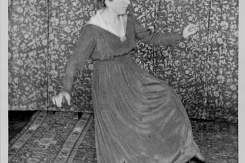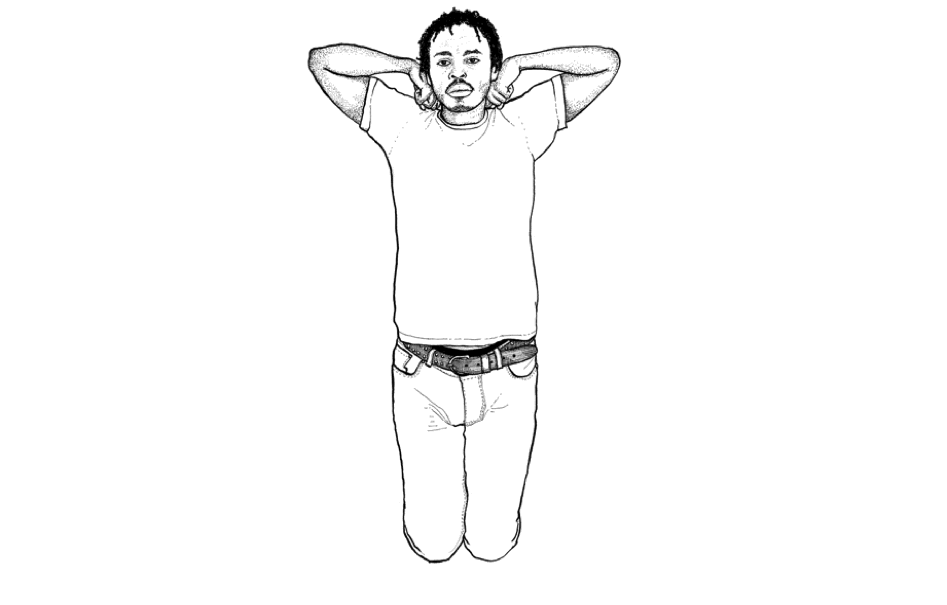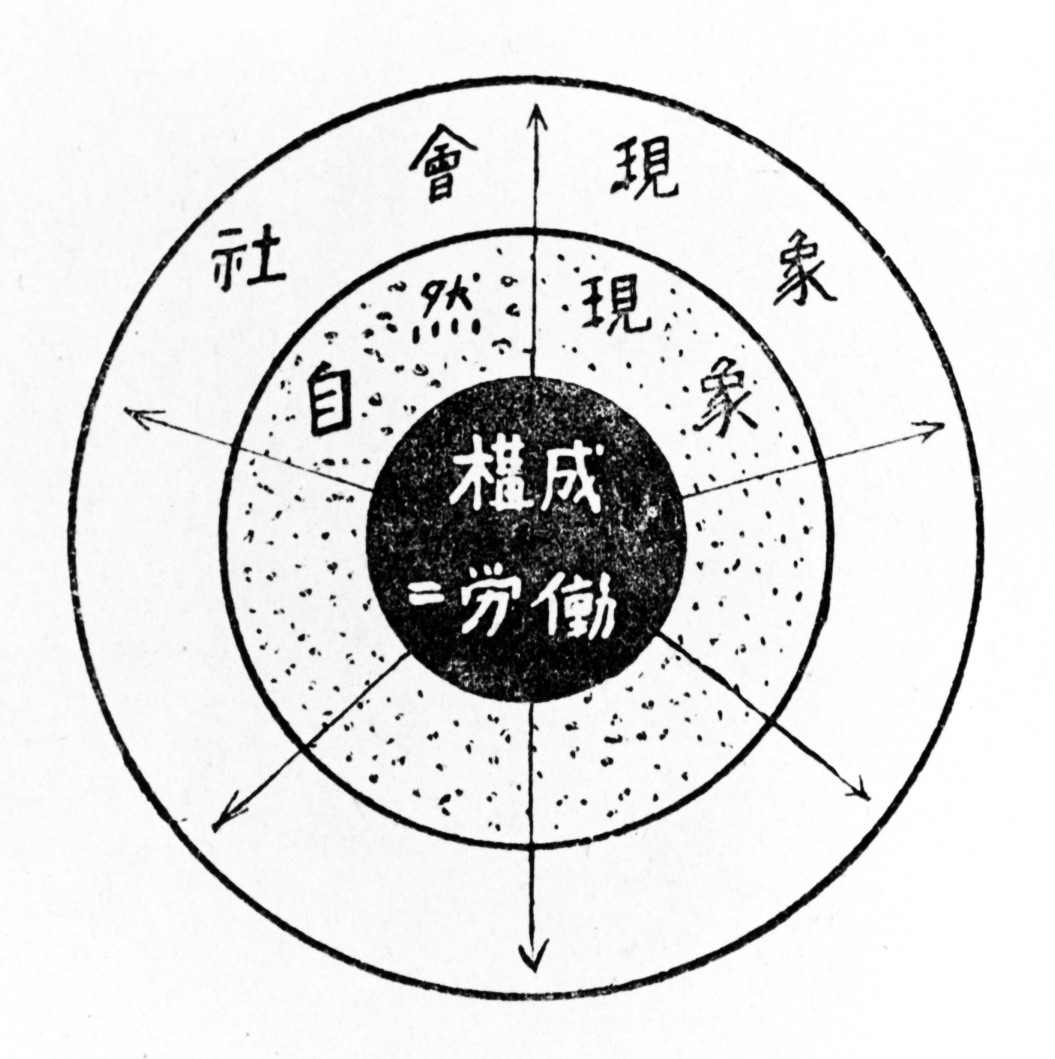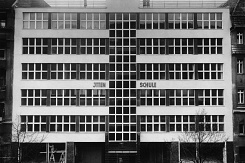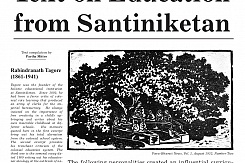The manifesto is about DIN A4 in size, but a little slimmer. On its cover is a picture of a cathedral, which stands for the Gothic builder’s shed. From the point of view of the romantic misapprehension of the Gothic period that prevailed at the time, in order to build such a collective, work the craftsmen met in such a hut and there formed an egalitarian labor association.
If you examine this illustration closely, you will see that around the cathedral spire three stars are formed by rays of light. Today we know that they represent the three most important arts: painting, architecture and sculpture. The meaning of these stars, according to the Bauhaus and Walter Gropius’s vision, is that the arts come together in the cathedral, creating a common building that is in itself a great work of art.
After opening the pamphlet, the manifesto text immediately begins with a declaration of principles, introduced by a frequently quoted sentence printed in blocked script: “The ultimate goal of all art is the building.” Here architecture is placed in the foreground and declared the most important goal, and this is also reflected in the word “Bauhaus” (a blend of the verb “to build” and the noun, “house”). Many, including myself, are of the opinion that the invention of this wonderfully powerful word is one of Gropius’s most important creative achievements— today the term “Bauhaus” is no longer translated into any other language but leads a life of its own.
The second important sentence refers to the illustration: “Architects, sculptors, painters—we must all turn to the crafts. … The artist is an exalted artisan.” So, here we find new relations, a new humility towards craftsmanship, towards doing. When prospective students finally arrived at the manifesto’s programmatic section, they found the goals of the Bauhaus formulated a second time: the unified work of art, the great building. Then follows the organizational principles of the Bauhaus, including commissions for students, joint planning, new experiments in exhibitions or the fostering of friendly exchanges with like-minded institutions, as well as theatre performances, lectures, poetry, music, costume festivals, assembling in cheerful ceremonies … in other words, what we would today call “culture.”
Only on the last page does one finally arrive at the curriculum, divided into “architecture,” “painting” and “sculpture.” And in the end comes the subject of craft training, with an enumeration of the different workshops. There weren’t actually any workshops for sculpting, stonemasonry or stucco plasterers, but wood sculpting, ceramics and plaster casting are mentioned and these did not yet exist either. Carpenters, decorative painters, weavers … in reality there were only female weavers.
For these workshops, the craftsmanship as well as the theoretical training is described in more detail: construction drawing, lettering, the science of materials, the theory of colors … even bookkeeping was taught here. And in the end, three grades are named and elaborated in a hierarchical structure consisting of apprentice, journeyman and young master—the latter could actually become masters.
After the First World War, the most important goal was, of course, to attract new pupils. That is why the Bauhaus manifesto was enclosed with many magazines or mailed out upon request. Today, we know that it really did attract many young people to the Bauhaus who said: “That’s where we must go!” These included Josef Albers, for example, and also Gunta Stölzl.
The Bauhaus also undertook a tremendous media campaign and modernized the then current means of media communication. From the very beginning the school constantly produced magazines, leaflets, exhibitions and catalogues, as well as holding lectures in order to promote the new cause. This media offensive of the Bauhaus was incredibly important.
Prior to the Bauhaus there had been manifestos, but up until then they had only been written by visual artists—for example, by the Expressionists, the Brücke Group. Ideas contained in many of these extant manifestos were integrated by Walter Gropius into the Bauhaus literature. The most important of his ideas, however, did not date very far back, but originated in the Arbeitsrat für Kunst (Workers Council for Art), founded in 1918, where Gropius’s architectural colleagues had formulated very similar ideas. For example, the Bauhaus manifesto contains the following notion: There is no boundary between arts and crafts and sculpture or painting. Everything is one: building. This was not originally formulated by Gropius but by Bruno Taut. So, Gropius took up many of the ideas that had been developed and discussed in the Arbeitsrat für Kunst a few months earlier and formulated them again in a new, fresh, attractive way.
Today, in my opinion, we can no longer imagine what the abdication and exile of the Kaiser signified. It meant the collapse of an entire system. As a result, the Russian and German revolutions broke out and Germany was transformed into a republic. Today we can no longer imagine the force of these tremendous upheavals. These drastic changes made people in Germany aware that things could no longer go on as they were, that new spaces for thought and design had to be opened up. With his manifesto Gropius penetrated these spaces.
This awareness was also reflected in the choice of teachers to staff the Bauhaus, who were representatives of some of the most radical artistic currents of the time. But if one is to reject one’s own history, from whence the foundations of design at that time originated—the building typologies and decorative forms—what is then the source of design? Thus, the early Bauhauslers were faced with the enormous task of providing a new theoretical basis for design, one which no longer lay in the past. As a result, a consensus gradually emerged that these could be the primary colors, that these could be the basic forms, that this could be a natural shape, as in the work of Paul Klee, that man could be the focus of attention, as in Oskar Schlemmer’s theatrical work.
Each of the masters developed his own approach according to this anti-historical basis. Johannes Itten had, of course, read Wassily Kandinsky’s books from 1912 during his time in Stuttgart and Vienna, and from his reading he extracted the concept of the basic forms. He brought these ideas, together with what he had learned from Adolf Hölzel concerning the elementarization of artistic means, and from these sources developed the first preliminary course, or basic teachings.
Of course, Josef Albers integrated many of the things he had learned and observed while studying with Itten into his own course. But he added a new element, a kind of “economy”: students must not produce any waste—there must be no waste—so their work must be thought and designed economically. No longer were students asked to discover themselves but, rather, to solve a task pragmatically: for example, to work on a piece of paper lying flat so that it can stand by itself, or bend a straight piece of wire in such a way that it achieves stability, becoming a small construction.
In my opinion Hannes Meyer remains underestimated for his politics, as well as his decision to hire Walter Peterhans, a very important aspect of his new appointment policy. Peterhans was very interested in achieving very precise control over the photographic development process, the precision of recording details, and taught accordingly. These things did not at all interest László Moholy-Nagy, who showed no interest in photo developing. But precision and predictability were also characteristics of Hannes Meyer and this connected him to Peterhans. In addition, a new aesthetic quality came into the Bauhaus because of Hannes Meyer cultivating a very deliberate approach to photography.
The Bauhaus curriculum changed all the time and is not easy to follow from one semester to the next. A secondary school diploma was not necessary—one could have a craft or even artistic background. The pool of prospective students was not homogeneous but possessed different educational paths. And everyone was looking for something new—in other words for what Gropius had to offer at the Bauhaus.
With the coming of the Weimar Republic, women finally had academic freedom and could attend any school of their choosing. Thus, many women came to the Bauhaus, and were indeed welcomed explicitly by Gropius in his opening speech, where he stated that there would be no difference between the “beautiful and the strong sex; absolute equality, but also absolutely equal duties. No consideration for ladies. In our work all are craftsmen.” There followed a whole series of approaches and arguments regarding the large number of women in the student body. On the one hand they were rejected, on the other hand the Bauhaus women themselves founded a women’s class. Many also found the work in the textile workshop very important and crucial.
In 1919, there were no other possibilities than to start first with the handicrafts, because at that time German industry was on its knees. The factories were destroyed and everything had to be rebuilt—so one could really only begin with handicrafts. The pupils should be qualified for building by first working with a craft in a workshop, with the aim of later executing larger projects together. Walter Gropius always wanted to build in an exemplary fashion and to create models that others could measure themselves against. That’s the only function of a school: it can’t constantly erect buildings—after all, this has always been the conflict between production and teaching. And it was precisely this conflict that for many years was very fruitful and influential at the Bauhaus.







